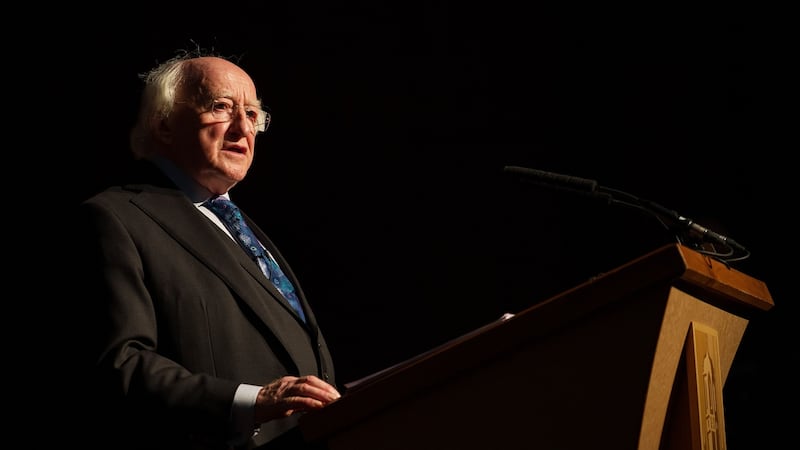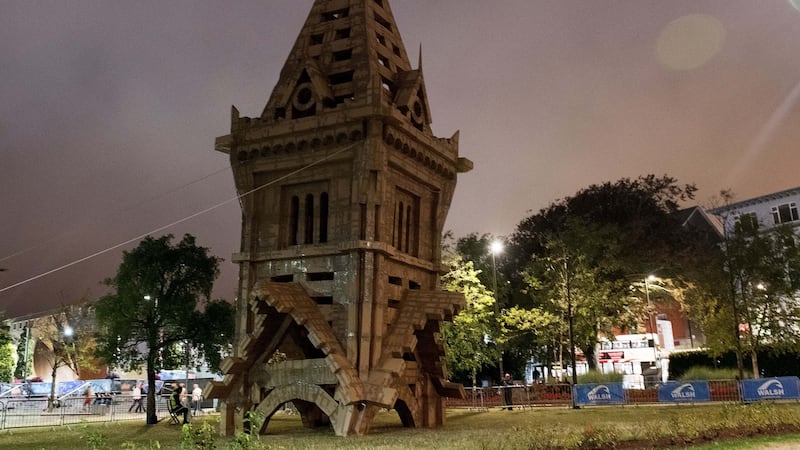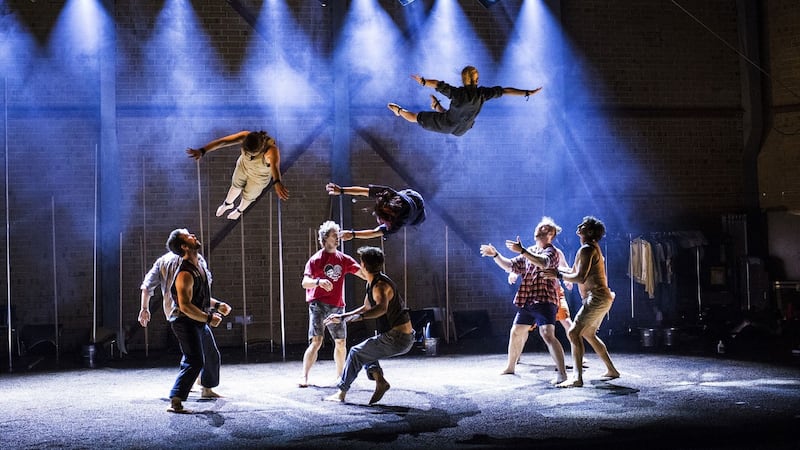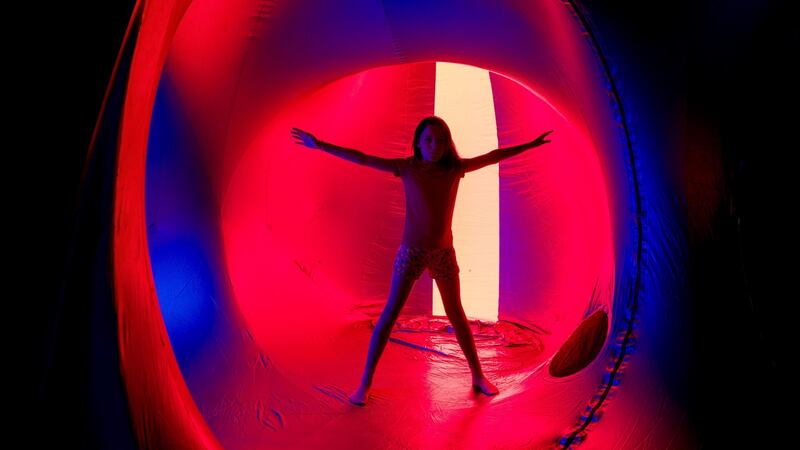“It was always difficult getting an audience for my 9am lectures on sociology,” President Michael D Higgins joked to the 600-strong crowd gathered at NUI Galway’s Bailey Allen Hall at 10am on Saturday. It was midway through Galway’s fortnight-long international arts festival, and the President was referring to the days when he used to lecture at this same university. In those days, his students – like students everywhere – were less than enthusiastic about lectures timetabled for first thing in the morning.
The President was giving the opening address in the festival’s First Thought Talks, and the early start on this occasion proved no obstacle for the crowds who turned up to hear him speak. In fact, so many people registered in advance that the talk had to be moved from the university’s Aula Maxima to this much larger venue.

Home, in all its many varied forms, was the theme of the weekend-long talks, curated by Catriona Crowe. The President, in a wide-ranging address, referred to "the century of the immigrant". He also called for a widening of the debate on Ireland's ongoing housing crisis, where many people from all backgrounds are struggling to find their own homes.
Immersive ‘Flight’
As it happened, immigration was the theme of Flight; an utterly gripping and immersive show of 45 minutes by Scottish theatre company Vox Motus, and the festival's unmissable show to date. It is running several times a day at the O'Donoghue Theatre, with a limit of 25 people a show. Each audience member in turn enters their allotted booth; all of which are laid out in a vast circular installation.
The title refers to the flight of two young Afghani brothers, who are trying to escape overland from Kabul to reach London, and to what they believe is freedom. An audio narrating the story of their journey comes through on headphones as you watch a carousel of scores of tiny three-dimensional scenes move past. It's the closest experience to watching a graphic novel come alive; a story you follow and devour by craning and crouching to see which window will light up next, and thus reveal the next compelling frame of the narrative.
We will look back on paper as having the same status as people trading in feathers or shells
Part of the magic of Flight is that is delivers a powerful political message about the difficult topics of immigration, exploitation of migrants, and a loss of innocence, while also being beautiful, imaginative, and visceral storytelling. If you didn't think you could care deeply about the fate of plastic models barely an inch high, Flight will prove you wrong.
Public installations
Over the weekend, two vast public installations came into existence – one in Eyre Square, and the other on the shores of the Corrib near the rowing club. The People Build projects were devised by French artist Olivier Grossetête, who was running round on Saturday afternoon at the riverside, directing the scores of members of the public who turned up to help build a huge bridge made of cardboard.

“Children love it because it’s like play on a big scale; like playing with Lego,” he said.
At that point, sections of the bridge were lying on the ground, being fastened together with masking tape. Young Galwegians Brendan O’Connor (7) and his sister Emma (5), were among those busily lifting boxes and taping. Asked how many rolls of masking tape would be used to stick the bridge together, Brendan answered 59 and his sister 102.
"Twelve kilometres of tape," John Ashton, venue manager said, which is a whole lot more than 102 rolls. The bridge was to be transported on pontoons later in the day to float on the Corrib, within sight of the festival's Big Top and the Salmon Weir Bridge.
I walked through Eyre Square en route to a show and when I returned there was a tower made of cardboard boxes, the second of Grossetête’s installations. This one began to resemble the Leaning Tower of Pisa as it slowly began a glorious collapse on one side over the period of a day. It was gone when I walked there again, sharing the square with the trio of Birdmen that periodically stalked the Galway streets; immense white bird-like dinosaurs with a penchant for trying to peck off human heads.

The Australian acrobatic company Gravity and Other Myths performed its startling show, Backbone, at the Bailey Allen Hall. Have you ever seen a human tower of four adults, with three of those four balancing on the head of the person beneath? No, me either. But this deeply intelligent show was not just about the extraordinary balance, flexibility and grace of its performers. It was about strange and moving storytelling; where the performers used such unlikely props as stones to convey loss, desire, and fortitude.
Cloud Study choreographed by John Scott, was billed as part running dance, part theatre and part athletics, and performed in the Festival Gallery by dancers Mufutau Yusuf and Salma Ataya. Unfortunately, whatever dialogue there was was almost totally inaudible, which left for a baffling and disappointing 40-minute show. There was earnest running backwards and forwards by the actors, sometimes through sections of the audience, following in promenade for part of the time, but despite literally running past audience members, the show ultimately failed to engage with them.
Cyberhomes
Novelists and journalists Andrew O'Hagan and John Lanchester spoke on the topic of Cyberhomes as part of the First Thought Talks, and the replacement of the actual with the virtual.
“We will look back on paper as having the same status as people trading in feathers or shells,” O’Hagan said, talking about how obsolete the printed word is destined to become in the way people conduct business and live their lives.
The housing crisis to which the President had referred was the topic of another talk during the weekend. Frank McDonald, former environment editor of The Irish Times informed the audience that there are now half a million one-off houses in the country. By 2040, the population is projected to have risen by another million. "Where will they all live?"
He showed a colour-coded map of the country, where red marked the areas where people commuted for more than one hour to work. Almost half the east side of the map was lit up. "We are seeing the Los-Angelisation of Ireland, which is Bertie Ahern's planning legacy, not that he would ever recognise that responsibility."
Office 33A, written and directed by Enda Walsh and voiced by Donal O'Kelly is a 15-minute show; the fifth in a series. Audience members, of which there were five others in my group, are first brought through what looks like Any Anonymous Office Corridor Anywhere, and then shown into a claustrophobic, near-derelict room; the former office of a waste management administrator, who meditates on his working life there, in almost total darkness.
This show cleverly uses its audience to mirror the way office colleagues everywhere interact with each other. Thrown together by a common goal, under the one roof, people are both in intimate proximity to each other, and yet are also as strangers to each other. In the rustling dark, startled faces are lit up unexpectedly as desk lamps come on briefly. You leave the show, wondering not just about the faceless administrator of Walsh’s sound installation, but the lives of those people you shared such a small space with for that short time.

By night, the Miracoco Luminarium lay in a flat puddle of white plastic in Eyre Square. By day, it transformed into an interlinking series of tents and circular corridors both immense and small, each one filtered in a different light; green, orange, red, blue and yellow. This was the most democratic of all Galway’s festival offerings, appealing equally to children and adults; beautiful spaces that were both playful and meditative.
The children ran through the illuminated corridors, gleefully exploring and playing hide-and-seek. The adults flopped down in some of the many various nook-like spaces, chilling out, staring at the jewel-like ceilings, and taking time to stop and reflect.
Full houses were cramming into Druid's tiny theatre to see Furniture and Shelter; sparky, moving and clever shows that will surely move on after the Galway festival to the wider audience they deserve.
Taylor’s, on Dominick Street, a once famous and beloved bar with the arts crowd, had spent recent inglorious years as a lap-dancing club. Now under new ownership, it reopened last week, and Galway’s festival goers turned out to revisit their old haunt; much extended but still with plenty of its former charm.
Among those who arrived on Saturday night to celebrate the re-opening was Sabina Higgins, wife of the President, and herself a former actress. That’s the Galway International Arts Festival for you; a resident of Áras an Uachtaraín mingling without fanfare in a bar with the city’s festival performers, crew, and locals.
Galway International Arts Festival runs until July 29th










